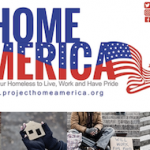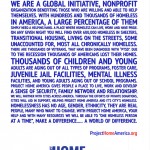Cory Butler, 20, sits in the living room of Rod’s House in Yakima, Wash. on Jan. 5, 2018. Butler has been homeless since he was 18, but has plans of getting his GED and becoming a tattoo artist. (JAKE PARRISH/Yakima Herald-Republic)
Yakima Herald-Republic
Each afternoon, Cory Butler heads to Rod’s House — a drop-in center for homeless youth and young adults in downtown Yakima — where he waits to be taken across town to a new overnight winter shelter for young adults.
Butler, 20, said he’s grateful for the shelter at Englewood Christian Church, where he’s been spending nights since it opened more than two weeks ago. He doesn’t fit in at adult shelters.
“There’s a lot of older people who don’t understand the younger generations — the way I dress, the way I talk would upset them sometimes,” said Butler, clad in dark jeans and a black pullover sweater with the top of his dark hair dyed a lighter color.
Yakima’s overall homeless problem is long-standing and quite obvious, but less visible is a rapidly growing population of homeless youths and young adults, such as Butler, with few services to help them. For example, there’s no permanent overnight shelter in Yakima for minors, and placing young adults at facilities with older people could leave them vulnerable to sex trafficking, sexual exploitation and other problems, service providers say.
 Cory Butler, 20, sits in the living room of Rod’s House in Yakima, Wash. on Jan. 5, 2018. Butler has been homeless since he was 18, but has plans of getting his GED and becoming a tattoo artist. (JAKE PARRISH/Yakima Herald-Republic)
Cory Butler, 20, sits in the living room of Rod’s House in Yakima, Wash. on Jan. 5, 2018. Butler has been homeless since he was 18, but has plans of getting his GED and becoming a tattoo artist. (JAKE PARRISH/Yakima Herald-Republic)
There is no clear picture of how many homeless teens and young adults there are in Washington state — or in Yakima County — but a 2016 state report estimated more than 13,000 youths ages 12 to 24 were living on the streets statewide. Officials also look to growing numbers of homeless K-12 students not only as a possible clue of how big the problem may be, but also as ground-zero in battling the issue.
The numbers are startling: Over the past decade, the Yakima School District has seen its homeless student population nearly quadruple to just over 5 percent of its students this year.
Officials know those homeless students are at high risk of becoming chronically homeless adults, so state and local agencies are focusing their efforts on homeless youths and young adults in hopes of breaking the cycle and preventing an explosion in chronically homeless people.
That means helping homeless students find stable living situations so they can concentrate on school work, and helping homeless young adults between the ages of 18 and 24 find a place to live so they can get a job and become independent, said Jim Theofelis, executive director of A Way Home Washington, a statewide coalition of service providers and state agencies focused on helping young adults out of homelessness.
“We need to have a system that understands (that) 18-to-24-year-olds are our best, last chance to interrupt the pattern of homelessness,” Theofelis said.
 Cory Butler organizes donated clothes inside Rod’s House closet in Yakima, Wash. on Friday, Jan. 12, 2018. Butler helps out at Rod’s House whenever he can. (JAKE PARRISH/Yakima Herald-Republic)
Cory Butler organizes donated clothes inside Rod’s House closet in Yakima, Wash. on Friday, Jan. 12, 2018. Butler helps out at Rod’s House whenever he can. (JAKE PARRISH/Yakima Herald-Republic)
Extent of the problem
Determining the number of homeless young adults isn’t easy. Unlike their older counterparts, they are less likely to participate in surveys, such as the annual “Point in Time,” which counts the number of homeless in the state. A lack of associated services focusing on older teens and young adults also makes tracking them difficult, said Josh Jackson, director of Rod’s House. In addition, many have experienced bad situations in foster care, detention centers and other programs and are therefore less likely to seek help, he said.
“It takes time to build trust with a population that wants to stay underground,” Jackson said. But there are indications homelessness among youths and young adults is on the rise statewide.
The number of homeless students in grades K-12 in the state has nearly doubled over the past 10 years. During the 2008-09 school year, there were 20,780 homeless students in Washington state, but by 2015-16 that number had jumped to 39,671 — 3.7 percent of the more than 1 million students statewide, according to the most recent data from the state Office of the Superintendent of Public Instruction.
It’s worse in the Yakima School District where the rate of homeless students nearly quadrupled over the same time period. The district’s homeless student population was 171 during the 2008-09 school year but grew to 847 by 2015-16, accounting for 5 percent of the district’s 16,200 students, OSPI data shows. Superintendent Jack Irion said he was surprised to see how much homelessness has grown among students.
“That’s a significant population of our students that are homeless,” Irion said. “When you come to school not knowing where you’re going to sleep that night, I think it’s pretty hard to focus on education.”
The situation is similar across Yakima County, where 2,614 homeless K-12 students were counted attending schools across the county during the 2015-16 school year — also 5 percent of the more than 54,290 students countywide.
Not all of those children and teens are sleeping on the streets. Many are homeless with their parents, “doubling up” with extended family or friends, while some are couch surfing and others are living in temporary housing or shelters.
Of the 847 homeless students in the Yakima School District during the 2015-16 school year, 685 were doubling up with other families, 66 were living in motels, 83 were in shelters and 13 were living on the streets, according to winter shelter coordinator Lee Murdock, also a member of the county’s homeless network.
The largest single group of homeless students — 81 — were in the second grade, and 89 students were homeless without their parents, Murdock said.
Last year, Rod’s House — which helps youth 13 to 24 with food, clothes and help getting back into school or finding a job — assisted more than 365 youth, up from 309 the year before, Jackson said. Of those, about half were between the ages of 18 and 24, he said.
“Trying to meet individuals where they are at (in life) is really important and there are far more (homeless young adults) than we can reach with great attention,” Jackson said.
 From left, DeShawn Gray, Hezekiah Harrington and case manager Terri Pace eat dinner at the kitchen table at Rod’s House in Yakima, Wash. on Friday, Jan. 12, 2018. (JAKE PARRISH/Yakima Herald-Republic)
From left, DeShawn Gray, Hezekiah Harrington and case manager Terri Pace eat dinner at the kitchen table at Rod’s House in Yakima, Wash. on Friday, Jan. 12, 2018. (JAKE PARRISH/Yakima Herald-Republic)
Limited resources
There’s no permanent overnight shelter for youths in Yakima County. Rod’s House, situated in a two-story house on North Naches Avenue, is too small to house youths overnight and the organization lacks the funding needed to build a facility to accommodate overnight stays, let alone absorb the cost of qualified staff and liability insurance needed to run it.
Aside from the new young adult winter shelter, the county lacks homeless services specific to the 18-24 age group. And, accordingly, it earned low rankings in the 2016 state report when it came to serving homeless youths and young adults. The report was conducted by A Way Home Washington.
The county has only 17 beds for homeless youths, compared to 89 beds in smaller Thurston County, the report showed.
Yakima County ranks lowest in the state in getting homeless youths into stable housing, only addressing the needs of 16 percent of its homeless youths. By comparison, Spokane had the most success — helping 52 percent of homeless youths finding housing, the report showed.
The county ranks second to last in graduation rates among homeless students, with just 46 percent obtaining a high school diploma. That’s below the state average of 57 percent, the report said.
The report partly blamed those and other issues on a lack of coordination between the county’s many service providers, which in turn was hindering progress.
“There needs to be more cross-system and cross-agency collaboration in Yakima County. Resource limitations are the overwhelming concern of most service providers and service coordination is considered a luxury most cannot accommodate,” the report said.
Even so, Yakima is not alone in its struggle to help homeless youths and young adults. Of the 39 counties in the state, half do not have services to help homeless youths and young adults, the report said.
Responding to the statewide problem, lawmakers approved the Homeless Youth Prevention and Protection Act in 2015. The act established the state Office of Homeless Youth Prevention and Protection and fostered the formation of A Way Home Washington, which is co-chaired by Gov. Jay Inslee’s wife, Trudi Inslee.
Those groups plan to work with communities across the state to help devise homeless youth programs and provide funding for them.
In Yakima, a youth coalition has formed in an effort to foster better collaboration among service providers, said Jackson, who chairs the coalition.
“We have been, as a community, behind the curve. There are a lot of service providers working but not systematically,” he said. “Now we’re all meeting in a group to tackle it as a community.”
 Anixa French photographed in her apartment in Yakima, Wash. Tuesday, January 5, 2015. French, who currently attends YVCC, has been in foster care since the age of 13. Youth up to age of 24 need their parents’ income information in order to apply for financial aid. (MASON TRINCA/Yakima Herald-Republic)
Anixa French photographed in her apartment in Yakima, Wash. Tuesday, January 5, 2015. French, who currently attends YVCC, has been in foster care since the age of 13. Youth up to age of 24 need their parents’ income information in order to apply for financial aid. (MASON TRINCA/Yakima Herald-Republic)
Solutions
This year, Yakima has taken a step forward in reaching homeless young adults by establishing its first winter shelter devoted to homeless people ages 18 to 24. The shelter, Butler says, means he has a place to go — a refuge not possible if he had to go to a shelter housing older homeless adults.
Past experiences at those shelters have left the 20-year-old feeling vulnerable, he said.
Last summer, Butler stayed at Camp Hope behind the former Kmart on East Nob Hill Boulevard, where he says he was intimidated by others.
A woman there took away a puppy Butler obtained from the nearby Yakima Humane Society after criticizing the way he was caring for the animal, and a man kept telling him he’d be drafted into the military, sent to Iraq and be killed, he said.
Tension grew, Butler said, and the man began threatening to beat him up.
“There definitely was a threat there and that’s why I’m glad I’m at the youth shelter, where we’re all relatively the same age,” he said.
So far, about eight homeless young adults have been using the winter shelter nightly, but Jackson said that number will increase as word gets out.
“This is a group that has been staying outside a lot and they don’t have to stay outside this winter,” he said,
The new statewide focus on homeless youths and young adults is already bringing attention to Yakima and leading to more collaboration among local service providers. For example, Catholic Charities has received $632,000 in state grants and another $304,000 in federal funds specifically to house young adults, said program manager Callie Webster.
Seven young adults have already been housed using the grant money, with five more in the process of being housed. The funding will be allocated over three years, and those housed will eventually begin paying rent. The program aims to help individuals come off of assistance within two years, she said.
“The real hope and goal of this is for a true launch into financial stability and adulthood,” Webster said.
Although the Yakima School District has partnered with area service providers in the past to ensure homeless students receive services, it’s now directed staff to determine the leading causes of homelessness among students and devise a plan to prevent it. One finding is that often poor communication prohibits families from solving conflict, and that results in homelessness, Irion said.
“What are we doing as a community to teach those skills? Because those are teachable,” he said. “We want to address that — that’s why we’re headed down this second path.”
Meanwhile, the state Office of Homeless Youth Prevention and Protection along with A Way Home Washington is embarking on a plan to help funnel grants to local communities in need of services.
And Yakima has caught the state’s attention, said Kim Justice, the agency’s executive director.
“Yakima is a community we’ve been paying a lot of attention to,” she said. “They’ve created a coalition on youth and young adults, they meet regularly and are working to find solutions.”
One such fix may be to establish a host-home program where youths can live with a family without the family being required to obtain a foster-care license, she said.
Another solution may include building shelters, one for minors and another for young adults, she said. But much work would be needed to provide the data needed to define such a project and secure funding.
The state and A Way Home Washington later this year will select eight to 12 communities across the state to help do the work needed to establish more services such as shelters, Theofelis said. Although A Way Home Washington has yet to make a decision, Yakima would be considered, he said.
Despite the challenges, Theofelis and other advocates are confident the problem of teen and young adult homelessness can be solved.











